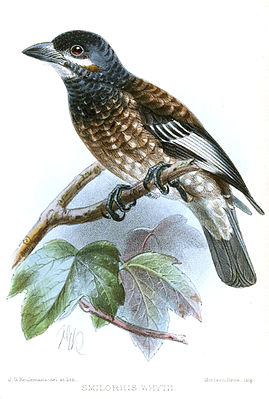Mirror Bearded Bird
| Mirror Bearded Bird | ||||||||||||
|---|---|---|---|---|---|---|---|---|---|---|---|---|

Mirror Bearded Bird |
||||||||||||
| Systematics | ||||||||||||
|
||||||||||||
| Scientific name | ||||||||||||
| Stactolaema whytii | ||||||||||||
| ( Shelley , 1893) |
The Mirror Barbet ( stactolaema whytii ) is a bird art from the family of the African barbets. The inconspicuously brownish feathered and compactly built species occurs in Africa south of the equator. Several subspecies are distinguished. The IUCN classifies the mirror bearded bird as not endangered ( least concern ). It was named after the Scottish naturalist Alexander Whyte , who was active in what is now Malawi on behalf of the British government.
Appearance
The males of the nominate form reach a wing length of 9.0 to 9.4 centimeters. Otherwise, body measurements are only available for subspecies. The subspecies Stactolaema whytii sowerbyi, for example, has a wing length of 8.8 to 9.8 centimeters, a tail length of 5.2 to 5.6 centimeters and a beak length between 1.6 and 2.0 centimeters. Females have similar body dimensions. Otherwise - as is typical for Stactolaema species - there is no noticeable sexual dimorphism .
The males of the nominate form have a dark top part, a thin pale yellow line separates the base of the beak from the top and continues as a stripe across the eyes. A yellowish-white line runs below the eye region. Otherwise the face is gray-black, the top of the body is brown. The control springs are black-brown on the top and gray-brown on the underside. The chin is whitish, throat and chest are brownish, with the feathers each slightly paler. The sides of the body are darker than the middle of the underside of the body. The flanks are brown and white, the middle of the abdomen to the under tail coverts is white with brown spots. The beak is black, the eyes are brown. The featherless skin around the eyes is dull black. The legs and feet are gray-green to black. The individual subspecies differ from the nominate form in that they have slightly different facial features. The subspecies S. w. angoniensis, for example, has a more yellow feathered face.
The mirror-bearded bird differs from the white-eared bearded bird , which belongs to the same genus, by its partially white hand wings. The straw-headed bearded bird , unlike the mirrored bearded bird, has a largely yellow face and a yellow throat.
Distribution area and habitat
The mirror-bearded bird occurs in the south of the DR Congo , in Zambia, Tanzania, in the northeast of Zimbabwe, in the south of Malawi and in the north of Mozambique. It occurs in forests at an altitude between 760 and 2500 meters. Its habitat is the miombo , open forests and occasionally gardens. It is regionally frequent, typically parapatric with the other members of its genus , which indicates that it is in competition with other species of its genus.
Way of life
The mirror-bearded bird is a socially living bird that occurs mainly in small flocks. These are probably parent birds with fully grown offspring that live in the territory of the parent birds and participate as helper birds in the rearing of their siblings. They are cave breeders, the nest tree is the center of their territory.
The food of the mirrored bearded bird consists of fruits and berries as well as insects. They often catch grasshoppers and dragonflies in flight. Other insects, such as ants, are caught when the mirror bearded birds search the foliage and bark of trees and bushes. While foraging for food, mirror bearded birds sometimes hang upside down on branches, like tits. Very rarely do they come to the ground for foraging. During the foraging for food, the members of a group are very lively and there are frequent interactions between the individual group members. Where - as in Zambia - its range overlaps with that of the Collared Bearded Bird , there is also aggressive interactions with this species.
The small honey indicator is one of the breeding parasites of the mirror bearded bird . In principle, there is always one member of the troop at the opening or in the nesting cavity, which is usually successful in preventing the small honey indicator from entering the nesting cavity.
The breeding season falls from September to November. The clutch consists of up to five eggs. The breeding season is not known. Newly hatched mirror bearded birds are initially only fed insects, later increasingly also fruits. The nestling period is around 40 days. Helper and parent birds also spend the night in the nest during the nestling period.
supporting documents
literature
- Lester L. Short, Jennifer FM Horne: Toucans, Barbets and Honeyguides - Ramphastidae, Capitonidae and Indicatoridae . Oxford University Press, Oxford 2001, ISBN 0-19-854666-1
Individual evidence
- ^ "Whyte." In: Bo Beolens, Michael Watkins, Michael Grayson: The Eponym Dictionary of Birds. Bloomsbury Publishing 2014; o. S.
- ↑ Short et al., P. 141
- ↑ Short et al., P. 140
- ↑ Short et al., Pp. 141 and 142
- ↑ Short et al., P. 142
- ↑ Short et al., P. 143
Web links
- Stactolaema whytii inthe IUCN Red List of Threatened Species 2013.1. Listed by: BirdLife International, 2012. Retrieved September 24, 2013.